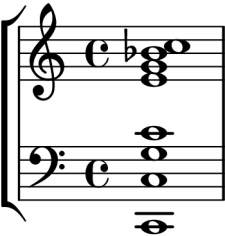The Dimensions of Tonal Music
Harmonic (Overtone) Series Through the First Eight Partials
512 Hz – Seventh Overtone / Eighth Partial
448 Hz – Sixth Overtone / Seventh Partial
384 Hz – Fifth Overtone / Sixth Partial
320 Hz – Fourth Overtone / Fifth Partial
256 Hz – Third Overtone / Fourth Partial
192 Hz – Second Overtone / Third Partial
128 Hz – First Overtone / Second Partial
64 Hz – Fundamental / First Partial
Harmony
The optimal vertical element – the most stable and “natural” harmonic sonority.
| Preference | Interval between bass and any upper voice | Interval between any upper voices | Harmonic Quality | Doubling in four parts (R = Root, 3 = Third, 5 = Fifth) | Spacing |
|---|---|---|---|---|---|
| Most preferred | Perfect Octave | Perfect Octave | Major Triad | RR53 | Larger intervals between lower voices; smaller intervals between higher voices; no more than an 8ve between S-A and A-T |
| Perfect Fifth | Fifth / Fourth | Minor Triad | |||
| Major Third | Major Third, Minor Third | ||||
| Minor Third | Major Sixth, Minor Sixth | ||||
| OK, but less preferred | Major and Minor Sixth | Diminished Triad | R553, RRR3 | ||
| R533, RR33 | |||||
| Even less preferred | Sevenths | Sevenths | Seventh Chord | RR55, R555, RRR5, R333 | S-A or A-T greater than 8ve; T-B relatively low in their ranges and a 3rd apart |
| Seconds | Seconds | Augmented Triad, Extended Tertian Harmony (9ths, 11ths, etc) | |||
| Fourths, Augmented and Diminished intervals | Augmented and Diminished intervals |
Melody
The optimal horizontal element – The most perceptually coherent line.
| Preference | Generic Interval Size | Scale | Quality of Interval | Other |
|---|---|---|---|---|
| Most preferred | Second | Within prevailing diatonic space | Perfect, Major, Minor | Interesting shape (such as “arch”); Maintains inertia; Goal-oriented; Leap in one direction followed by a step in opposite direction |
| Common Tone (Octave) | ||||
| OK, but less preferred | Third | Diminished | ||
| Fourth, Fifth | ||||
| Even less preferred | Larger leaps (6ths, 7ths) | Outside prevailing diatonic space | Augmented | Difficult to sing, Monotonous |
Counterpoint
The optimal interaction between two lines – each line remains independent and perceptually distinct (soprano and bass counterpoint most important in textures of three or more voices).
| Preference | Relationship Between Lines | Lines in Close Proximity |
|---|---|---|
| Most preferred | Contrary motion | No voice crossing; no lines in unison |
| Similar / Oblique motion | Lines move by contrary motion into or out of a unison | |
| Parallel Motion (of intervals other than 5ths and 8ths) | ||
| OK, but less preferred | Similar (Unequal) Fifths (d5 to P5, or vice versa) | Lines move by similar motion into or out of unison |
| Even less preferred | Parallel perfect 5ths and 8ths | Voice crossing |
A Simple Theory of Voice Leading
Voice leading in tonal music represents the best possible compromise among these three competing priorities: optimal harmony, optimal melodic motion, and optimal interaction between melodic lines. Each of these three priorities is as good as the other priorities will allow.
